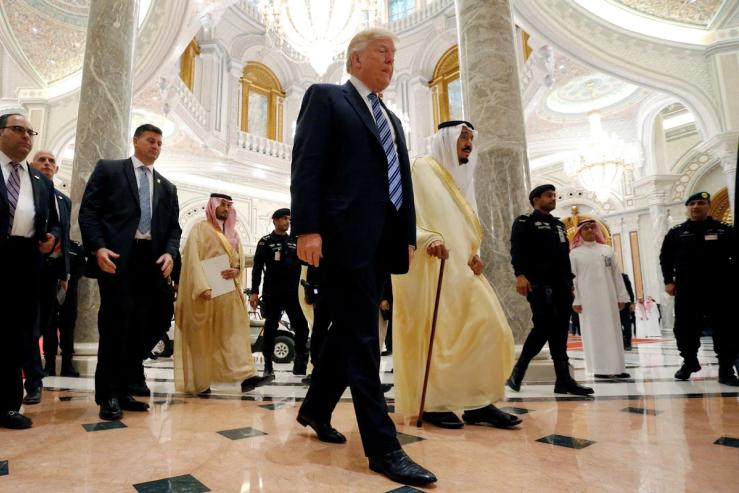It has been a dynamic period in US-Gulf relations. A steady stream of senior Gulf officials has visited Washington to engage the new administration. There have been talks to end the Russia-Ukraine war in Saudi Arabia, the Gaza crisis in Qatar, and nuclear negotiations with Iran in Oman.
President Donald Trump likely had such summitry in mind when he planned his first major foreign trip of his second term — to Saudi Arabia, Qatar, and the UAE on May 13–16. But several of these diplomatic tracks are stalled. Russia remains unmoved by US overtures. The planned release of US-Israeli hostage Edan Alexander is welcome news, but hard work remains to forge a durable new ceasefire and end the Israel-Hamas war. Saudi-Israeli normalization remains distant.
There is, however, another compelling opportunity: to forge a US-Gulf economic corridor focused on deepening investment and technological cooperation. This builds on efforts across administrations and reflects shifting regional priorities. Gulf leaders, having undergone a generational transition to younger rulers, are seeking to build resilient, knowledge-based economies, and see economic and technological ties — not just defense — as central to their US relationships.
For Washington, the stakes are rising. Trump is asking allies to invest in the US as he wages a trade war and stirs economic uncertainty. Gulf countries have nevertheless signaled intentions to increase US investments: Saudi Arabia, the UAE, and Qatar have announced US investment plans exceeding $2 trillion.
For that, Gulf countries want clear domestic returns. Despite excitement around Saudi Vision 2030, foreign direct investment into Saudi Arabia fell for a third straight year in 2024. The UAE has fared better, succeeding in attracting asset managers, and more than tripling assets under management in Abu Dhabi’s financial free zone last year. Other Gulf states are mobilizing capital to attract private equity firms and support startups. While American companies are engaged in the region’s ambitious socioeconomic transformation plans, Gulf governments want greater buy-in from US multinational firms and investors.
What can a presidential trip accomplish? These visits often generate splashy announcements — aircraft sales, for example — but lasting impact depends on policy reforms and follow-through. Streamlining foreign investment processes is one such area. Gulf investors still see the US as a safe place to deploy capital, especially in uncertain times. The Committee on Foreign Investment in the United States (CFIUS) review process rightly protects national security and critical infrastructure, but it can be made more efficient, predictable, and timely. A recent executive order aims to improve the CFIUS process. If done responsibly, this would benefit the US economy as well as foreign investors.
There’s also potential for joint investments in strategic countries like India or in sectors such as critical minerals and infrastructure. Grand efforts to integrate economies from India to Europe via the Middle East face political headwinds, but there are still opportunities for government and private-sector actors to enhance connectivity between these regions.
Artificial intelligence is another focal point. Gulf governments and businesses are eager to partner with US AI firms and are open to strict security standards to stay in the US tech ecosystem. Their massive investments in US data centers and tech firms can help America scale its domestic infrastructure while also modernizing their own economies — from UAE-based data centers operated by US firms to Aramco’s AI-powered oil exploration.
Security, safety, and end-use controls remain key policy issues, especially with US concerns over China. But with thoughtful policy, the US can both protect its interests and deepen economic ties with the Gulf.
The Trump administration recently announced that it would not implement the previous administration’s regulations regarding the global diffusion of advanced semiconductors. The Biden-era policy had been set to go into effect on May 15 while President Trump is slated to be in the Gulf. Less clear is what set of rules, standards, and expectations will replace the now-jettisoned global policy. The forthcoming decisions will be watched closely from Silicon Valley to Gulf capitals and many places in between.
There will be economic friction points in US-Gulf relations as well, including over tariffs, unaligned energy interests, and differing views on China. And the Trump administration’s troubling refusal to steer clear of personal economic entanglements that create conflicts of interest will damage US public trust, even for endeavors that can benefit people on both sides. Focusing on bilateral economic ties also leaves unaddressed the growing gaps in assistance for the Middle East’s fragile states and vulnerable populations.
A US presidential visit is a rare moment. Leaders on both sides should seize it to build a more resilient and forward-looking economic partnership — beyond the trillion-dollar headlines.
Daniel Benaim is an associate fellow at the Middle East Institute. He previously served as Deputy Assistant Secretary of State for Arabian Peninsula Affairs and NSC Senior Director for Speechwriting and Strategic Initiatives and Special Assistant to President Joe Biden.
Dr. Robert Mogielnicki is a Senior Resident Scholar at the Gulf Arab States Institute, where he manages the political economy research portfolio, and an Adjunct Assistant Professor at Georgetown University’s Center for Contemporary Arab Studies.

